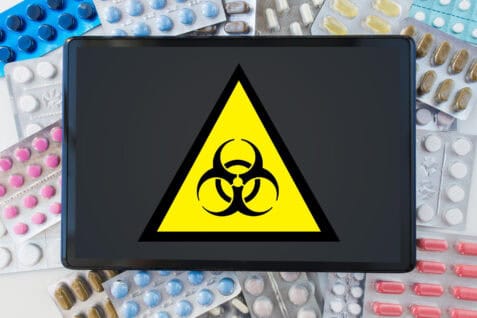Ways to Design an Ideal Hazard Communication Program

With fewer than 2,000 federal OSHA inspectors responsible for the health and safety of 130 million US workers (according to data from OSHA), your business cannot rely on them to point out areas for improvement. As an employer, your role includes taking responsibility for worker safety by building a hazard communication program (HCP) that allows your staff to remain safe from exposure.
However, what does it take to build this from the ground up, and how do you audit an existing program?
Below, we explain how to design the ideal program, including:
- Setting clear objectives
- Implementing strategic planning
- Leveraging technology to assist your processes
- Developing actionable program steps
- Creating a robust program tailored to your industry
Read on to discover how KHA’s tools and solutions, including its SDS management systems, can streamline this process further, giving you the best chance to avoid OSHA citations in the future.
Goals of a Professional Hazard Communication Program
The goals of an HCP aim to keep your workers and yourself as safe as possible by empowering everyone with the knowledge and skills to avoid significant problems in the workplace. It involves a wide range of work areas and learning methods to ensure peace of mind for everyone in the company. These goals include:
Ensuring Workplace Safety
HCPs offer employees an opportunity to minimize workplace accidents caused by improper handling of chemicals. They do this by providing employees with:
- Access to essential safety data sheets (SDS) for quick reference
- A clear understanding of how to leverage SDS
- Training in labeling hazardous materials clearly
- Knowledge of the risks associated with substances the company uses
- Steps to recognize and effectively respond to hazards
All of the above contribute to creating a strong workplace safety culture. This communal attitude enhances employee confidence in using chemicals and can further reduce employee mishandling and employer liability.
Achieving OSHA Compliance
The National Safety Council reports that over 650,000 nonfatal injuries occurred in 2021-2022 due to exposure to harmful substances or environments. In 2022 alone, 839 workplace fatalities also occurred for similar reasons. However, OSHA develops and ensures HazCom compliance with a clear set of guidelines with the goal of preventing these numbers from significantly increasing.
A clear HCP can ensure that your workers understand the importance of following OSHA mandates (such as 29 CFR 1910.1200‘s hazard communication regulations) and how to do so. They can also learn how up-to-date SDS can empower them to protect themselves and reduce the likelihood of receiving an OSHA citation.
High-quality training also allows employees to:
- Engage in periodic reviews and audits
- Help the workplace meet updated OSHA communication standards
- Use high-quality cloud-based software solutions for ongoing learning
- Respond to law updates as regulations evolve
Together, these skills can ensure your workforce independently reduces the likelihood of accidents.
Protecting Employee Health
Proper hazard communication significantly reduces the exposure an employee is likely to experience in relation to hazardous chemicals. It teaches them:
- How to avoid accidents
- Appropriate responses to accidents and spills
- What to report after an accident
- Appropriate PPE to use during hazardous materials handling
- How to communicate with anyone who responds to spills and accidents
According to The Guardian, accidents involving these materials occur almost daily in the US. Understanding the proper response to such circumstances can mean higher levels of safety, even if the worst happens.
However, this information is beneficial not only after an accident. It can also train workers on the long-term health risks associated with harmful chemicals, such as respiratory or skin issues. This information also helps emphasize the importance of PPE and how best to use it.
It can even empower employees to monitor safety procedures and update them based on the unique nature of their workplace to mitigate future risks.
Finally, it can help to address psychological safety less directly. Working with hazardous chemicals can be stressful, and proper training can relieve some of the burden by giving workers clear instructions on what to do at every step.
Essential Steps to Develop an Effective HCP
The first thing you will need to do is designate a safety officer or team. They will be able to oversee any HCP and delegate specific tasks further, becoming responsible and accountable for any in-work issues and training. Doing this reduces the likelihood of a “bystander effect” in the workplace, as OHS Online describes.
Develop a Training and Communication Plan
A written plan can help you detail policies and procedures for hazard communication and give you an unambiguous set of steps for others to comment on or respond to. It should outline:
- Responsibilities
- Emergency procedures
- Training schedules
- Sources of additional information
- Regulatory mandates to follow
Many regulatory bodies, such as OSHA, provide templates and guides for creating these. If they make sense for your business, use them as a basis for your HCP.
You can also use cloud-based tools and apps to host and organize these for future easy access.
Additional Steps for Maintaining an HCP
- Maintain an accurate inventory of hazardous chemicals
- Regularly audit every step of your chemical management
- Use KHA’s digital tools for real-time updates to handling steps
- Instigate clear labeling practices and ensure they meet standards
- Provide access to up-to-date SDS at all times
- Build a culture that emphasizes employee training and learning
It is also important to remember that you should never consider such programs “complete.” Review their effectiveness via employee feedback, analyze their effectiveness, and update them to ensure both old and new employees stay apprised of procedural changes.
Leveraging Technology to Enhance HCP and Compliance
Designing the ideal hazard communication program will ensure your workplace exhibits high levels of safety and complies with all appropriate regulations. KHA’s tools, such as our SDS management systems and mobile apps, can simplify this process and give your employees the best chance of remaining safe.
Leverage the best technology and software to empower employee training and ensure that hazardous materials are handled correctly. We can help with all of this, so start implementing HCP with experts in the field. Contact KHA to learn more and ensure you remain compliant long into the future.
